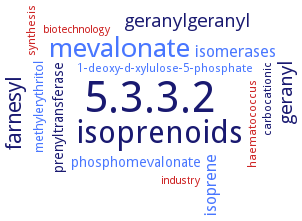5.3.3.2: isopentenyl-diphosphate DELTA-isomerase
This is an abbreviated version!
For detailed information about isopentenyl-diphosphate DELTA-isomerase, go to the full flat file.

Word Map on EC 5.3.3.2 
-
5.3.3.2
-
isoprenoids
-
mevalonate
-
farnesyl
-
geranyl
-
geranylgeranyl
-
isoprene
-
isomerases
-
phosphomevalonate
-
prenyltransferase
-
methylerythritol
-
haematococcus
-
synthesis
-
carbocationic
-
1-deoxy-d-xylulose-5-phosphate
-
biotechnology
-
industry
- 5.3.3.2
-
isoprenoids
- mevalonate
-
farnesyl
-
geranyl
-
geranylgeranyl
- isoprene
- isomerases
- phosphomevalonate
- prenyltransferase
- methylerythritol
- haematococcus
- synthesis
-
carbocationic
- 1-deoxy-d-xylulose-5-phosphate
- biotechnology
- industry
Reaction
Synonyms
fcd1, FNI, IDI, IDI-1, Idi-2, IDI1, IDP isomerase, IPI, IPI1, IPP isomerase, IPP-isomerase, IPP:DMAPP, IPPI, IPPI1, IPPI2, IPPISOM, Isomerase, isopentenylpyrophosphate DELTA-, Isopententenyl diphosphate:dimethylallyl diphosphate isomerase, isopentenyl diphosphate isomerase, isopentenyl diphosphate isomerase 1, isopentenyl diphosphate:dimethylallyl diphosphate isomerase, Isopentenyl pyrophosphate isomerase, Isopentenyl pyrophosphate isomerase:dimethylallyl pyrophosphate isomerase, isopentenyl-diphosphate delta-isomerase 1, Isopentenyldiphosphate DELTA-isomerase, Isopentenylpyrophosphate isomerase, Methylbutenylpyrophosphate isomerase, SlIPI, type 1 IPP isomerase, type 2 isopentenyl diphosphate isomerase, type 2 isopentenyl diphosphate: dimethylallyl diphosphate isomerase, type 2 isopentenyl diphosphate:dimethylallyl diphosphate isomerase, type 2 isopentenyl-diphosphate isomerase, type I isopentenyl diphosphate isomerase, type II isopentenyl diphosphate isomerase, type II isopentenyl diphosphate:dimethylallyl diphosphate isomerase, type-2 isopentenyl diphosphate isomerase, type-I isopentenyl pyrophosphate isomerase


 results (
results ( results (
results ( top
top





